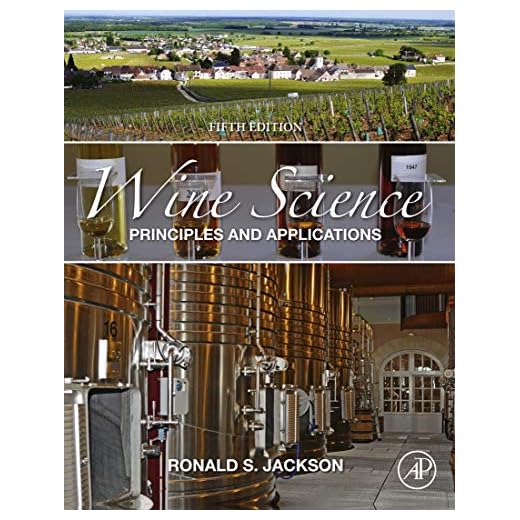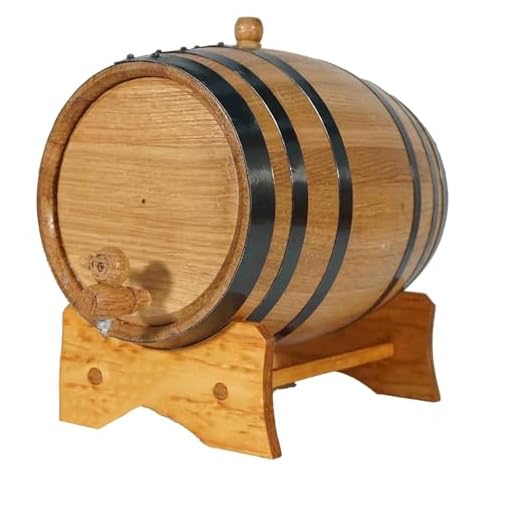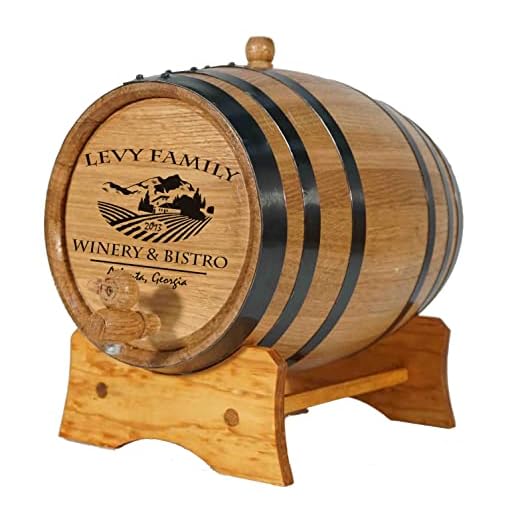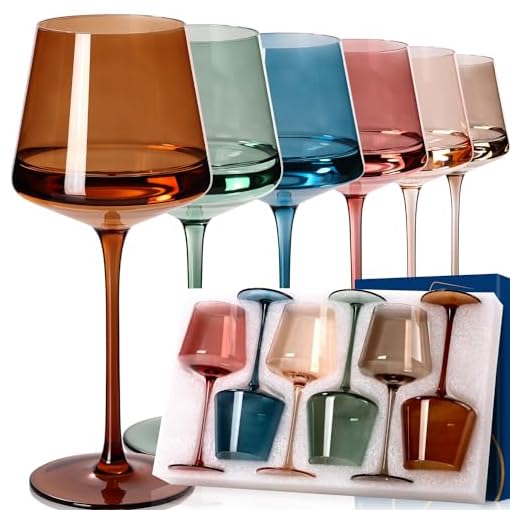



The intense color of this popular alcoholic drink primarily stems from the grape skins used during fermentation. The anthocyanins, natural pigments found in these skins, are responsible for the deep shades ranging from ruby to garnet. The longer the skins remain in contact with the juice, the richer the hue becomes. For those looking to explore, consider vintages where skin contact is maximized, as they often showcase more complex colors and flavors.
Temperature and winemaking techniques also play a pivotal role in achieving that characteristic tint. Warmer fermentation temperatures can enhance extraction from the skins, while methods such as cold soaking prior to fermentation can yield a smoother, more integrated color. If you’re curious about different styles, look for those made with minimal intervention for a unique expression of color and taste.
Lastly, remember that aging in oak barrels can subtly influence the appearance. While the primary color remains derived from the grape skins, the interaction with wood can add depth and a slight change in hue. For a memorable experience, seek out those that have spent time in oak, as they often present a beautiful spectrum in both color and flavor. Exploring these aspects will deepen your appreciation for this captivating drink.
Understanding the Color of Dark Beverages
To grasp the hue of these beverages, focus on the skins of the grapes. The pigment found in grape skins, known as anthocyanins, is the principal factor contributing to their coloration. During fermentation, the extraction of these pigments occurs, resulting in the distinctive shades that characterize each varietal.
Several techniques influence the depth of color, including:
- Fermentation temperature: Warmer temperatures enhance extraction.
- Skin contact duration: Extended maceration allows for greater pigment infusion.
- Grape variety: Different cultivars possess varying pigment concentrations.
Additionally, the maturation process can alter the appearance. Aging in oak barrels introduces complexities and can soften the color over time. This interaction with wood not only affects color but also imparts unique flavors and aromas.
For anyone interested in enhancing culinary experiences, pairing these beverages with dishes can elevate flavors. A good match can transform a meal, creating harmony between food and drink. If you’re curious about culinary timing, check out this source for insights on cooking turkey tails.
In conclusion, the interplay of grape skin pigments, fermentation methods, and aging techniques collectively define the color of these beloved beverages, offering a visual preview of their potential flavor profiles.
The Role of Grape Varieties in Color
To understand the hue of a particular varietal, recognize that the skin of the grape plays a significant role. The anthocyanins, responsible for the pigmentation, vary across different types. For instance, grapes like Cabernet Sauvignon and Syrah tend to have a deep, intense color due to their high anthocyanin content, while others like Pinot Noir yield a lighter shade.
Key Grape Varieties and Their Color Profiles
| Grape Variety | Color Intensity | Notes |
|---|---|---|
| Cabernet Sauvignon | Deep Purple | High tannins and rich flavor profile. |
| Merlot | Ruby Red | Softer tannins, typically fruit-forward. |
| Syrah/Shiraz | Dark Garnet | Bold and spicy notes, with a robust color. |
| Pinot Noir | Light Red | Delicate flavors, lower tannin content. |
| Zinfandel | Bright Ruby | Jammy fruits, often with a peppery finish. |
Each variety’s skin thickness and composition also contribute to the final color. For example, thicker skins generally lead to more extraction of color during fermentation. Additionally, the ripeness of the grapes at harvest alters the anthocyanin levels, impacting the overall appearance.
Blending different varietals can also enhance color depth. Winemakers often experiment with combinations to achieve the desired visual and flavor profile. Understanding these factors can greatly enrich your appreciation for the artistry behind each bottle.
How Skin Contact Influences Hue
Skin contact during fermentation is a key factor in determining the coloration of a beverage crafted from grapes. The pigments responsible for the rich tones in these beverages, primarily anthocyanins, are concentrated in the skin. The duration of contact between the juice and the skins directly impacts the depth and intensity of the color.
For optimal extraction, a maceration period of about 5 to 21 days is recommended. Shorter maceration leads to lighter shades, while extended periods yield deeper, more saturated colors. Temperature also plays a significant role; warmer fermentation temperatures enhance pigment extraction, resulting in a more pronounced hue.
Crushing techniques can influence skin contact as well. Whole berry fermentation, for instance, allows for gentler extraction compared to traditional crushing methods, producing a softer color profile. On the other hand, using techniques like punch downs and pump overs increases the interaction between juice and skins, intensifying color.
Additionally, the choice of vessel impacts the extraction process. Fermenting in open-top tanks facilitates more oxygen exposure, which can enhance the extraction of color compounds. Conversely, closed fermentation systems may limit this interaction, resulting in a different color outcome.
Ultimately, the art of skin contact management allows winemakers to tailor their creations, balancing the desired visual appeal with the complexity of flavors. Understanding these nuances is essential for anyone looking to appreciate the intricacies of these beverages.
Understanding the Impact of Fermentation Techniques
Employing temperature-controlled fermentation significantly influences the extraction of color compounds from grape skins. I recommend maintaining temperatures between 75°F and 85°F for optimal pigment development. Higher temperatures can extract more tannins, resulting in bolder hues and complex flavors.
Utilizing different fermentation vessels also alters the final appearance. For instance, stainless steel tanks allow for precise temperature regulation, while oak barrels add subtle color variations and aromatics. I often suggest experimenting with small batches in various containers to observe the differences firsthand.
Incorporating extended maceration can enhance color intensity. Allowing the must to remain in contact with skins beyond the primary fermentation phase can yield deeper shades. This technique requires careful monitoring as over-extraction may lead to undesirable astringency.
It’s beneficial to consider the use of carbonic maceration, particularly for certain varietals. This method promotes fruity, bright characteristics, while still retaining a vibrant hue. I encourage trying this approach with grapes like Gamay or Grenache for a fresh outcome.
Lastly, employing techniques like punch downs or pump overs during fermentation can enhance the extraction process. These methods facilitate better mixing of the must, ensuring that color and flavor compounds are evenly distributed. Observing these processes can dramatically impact the final product and its visual appeal.
Analyzing the Effects of Aging on Color Change
Oxidation plays a pivotal role in the transformation of hue. As tannins and anthocyanins interact with oxygen during maturation, the color shifts from vibrant purple and deep ruby tones to more brick-like shades. This evolution is not merely aesthetic; it indicates complex chemical changes in the beverage.
Factors Influencing Color Alteration
Temperature and storage conditions can significantly impact the rate of color change. Cooler environments generally slow down oxidation, preserving the initial vividness longer. Conversely, higher temperatures accelerate these reactions, often resulting in a quicker transition to lighter hues.
The influence of wood aging cannot be overlooked. Barrels impart compounds that can enhance or modify color. For instance, oak barrels introduce vanillin and other phenolic compounds, which can soften the appearance of darker colors, creating a more nuanced palette.
Time and Its Impact
As the years progress, the gradual sediment formation also affects visual perception. This sediment, resulting from the natural clarification process, can create a more opaque appearance. Wines left to mature longer often exhibit a clearer, more refined look, with the color settling into a harmonious balance.
Monitoring these changes is essential for those who appreciate the nuances of a well-aged bottle. Regular assessments can inform optimal drinking windows, ensuring that the sensory experience aligns with the drinker’s expectations.
Understanding these dynamics enriches one’s appreciation and approach to selecting bottles for both immediate enjoyment and long-term aging. Each vintage tells a story, and the color transformation is a critical chapter in that narrative.
The Influence of Terroir on Wine Color
Terroir plays a pivotal role in defining the hues found in your favorite bottles. The unique interplay of climate, soil composition, and topography directly affects the pigmentation of grapes and subsequently the liquid they produce. For instance, regions with ample sunlight and optimal temperatures typically yield grapes with higher anthocyanin levels, leading to deeper shades.
Climate Variations
Temperature fluctuations impact the ripening process. Cooler climates may produce lighter, more translucent varietals, while warmer zones tend to enhance color intensity. Additionally, rainy seasons can dilute pigments, resulting in a less saturated appearance. It’s essential to evaluate the climate of a vineyard when considering the potential color profile of its produce.
Soil Composition
The mineral content of the soil plays a significant role as well. Soils rich in iron or volcanic materials can impart unique color characteristics to the grapes. For instance, grapes grown in iron-rich soils often exhibit more vibrant colors due to increased absorption of nutrients that influence pigment development. Understanding the geological makeup of a vineyard can provide valuable insight into the anticipated color outcomes.
Ultimately, the terroir encapsulates a multitude of factors that converge to create the distinctive colors we observe in various grape varieties. This complexity is what makes exploring different regions so rewarding. Each bottle tells a story, reflected not just in taste, but also in its visual appeal.
Comparing Color Profiles of Different Red Wines
To truly appreciate the nuances in hue among various dark beverages, one must consider the factors influencing their chromatic profiles. For instance, a Cabernet Sauvignon typically showcases a deep, inky purple, while a Pinot Noir often presents a lighter ruby red. The variance in visual intensity is largely attributed to the grape’s skin thickness and pigmentation, which directly impacts extraction during vinification.
Cabernet Sauvignon vs. Pinot Noir
The heavier body of Cabernet Sauvignon results in a more concentrated coloration due to its thicker skins. During fermentation, the extended maceration period allows for maximum pigment extraction, yielding a wine that appears almost opaque. In contrast, Pinot Noir, with its thinner skins, does not undergo the same level of extraction, resulting in a lighter and more translucent appearance, which can range from bright ruby to garnet.
Malbec and Syrah Variations
Malbec tends to display a dark violet hue, often with an impressive depth that can rival Cabernet Sauvignon. This richness is enhanced by the specific terroir of the regions where it’s cultivated, such as Mendoza in Argentina. Syrah, on the other hand, offers a spectrum from deep purple to almost black, especially in warmer climates where it ripens fully. The interplay of climate, soil, and vinification methods can lead to significant variations even within the same varietal.
Understanding these color profiles not only enhances the visual experience but also informs tasting notes, food pairings, and overall appreciation of these exquisite libations. Each glass tells a story through its unique shade, waiting to be explored.











